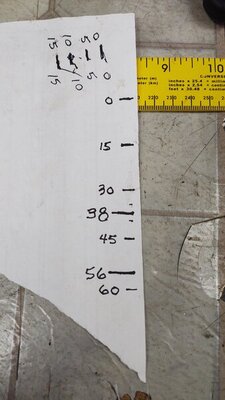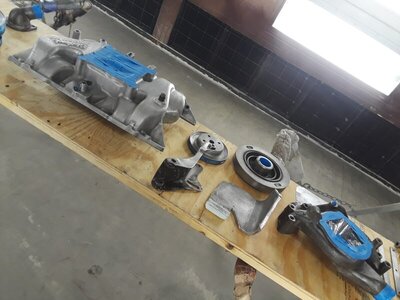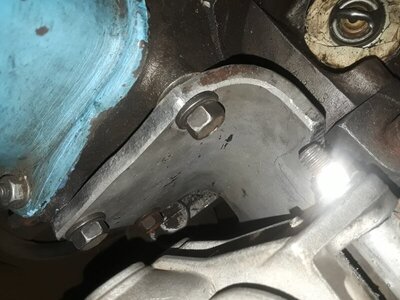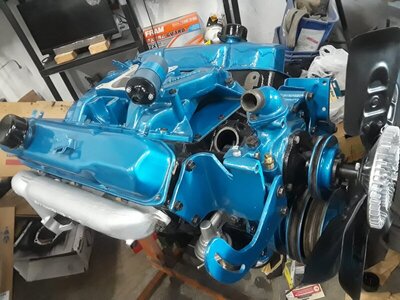- Local time
- 8:27 AM
- Joined
- May 14, 2011
- Messages
- 18,220
- Reaction score
- 35,470
- Location
- On the Ridge, TN
Sorry gentlemen, been thinking again....you know nothing good ever comes of THAT. 
As always, I disavow any responsibility for possible lost brain cells incurred by reading my posts, so read further at your own risk:
Today's weather is sort of crappy (storms blowing through to chase off the Sahara dust clouds or whatever that crap was), so I decided to try to sort out an issue with "jittery" part-throttle, low speed conditions in the GTX.
(For those who don't know, the engine is a '72 440 block with 452 heads, rebuilt by a previous owners' machine shop. It's pretty docile, having only a DC ".484" purpleshaft cam and has low miles on it. I've been in touch with the machine shop who built it and they reported "about 450hp" and promised to send me the dyno sheet a couple years back when I bought the engine.
Still waiting on that....
Big Hedmans, 3" dual all the way out the back, Edelbrock modern "AFB" type 750cfm carb.
That's about it, forged crank, nothing fancy.)
The car had been converted to Mopar electronic ignition before I bought it going on 10 years ago; The usual orange box controller, MSD Blaster II coil and I have a couple different electronic distributors to use on it, one a stock rebuilt whatever and the other, an old MP unit. Both are fairly new and tight.
I've always just played around with the timing on the engine and had settled on about 15BTDC or so - but something always ate at me about that:
It seemed a bit much for a fairly stock 440, least to me. Further, I'd not been able to connect the vacuum advance on either distributor without the "shakes" getting VERY pronounced just going down the highway, so I've always run it blocked off.
I've had a bunch of 440's over the years, none of them "built", just regular ol' Magnum this and that in various 60's cars.
Factory setting was supposedly 5BTDC, but my experience with most of them was that they "liked" about 10BTDC and if I pushed it much beyond that, the familiar rattle of detonation crept in usually.
I've been swapping back and forth between the two distributors I have and just playing around, UNTIL TODAY THAT IS.....
Today, Buford was gonna get SERIOUS about this stuff, get all HIGH TECH up in here.
Well, that usually means one needs accurate testing equipment and the harmonic balancer needs to have degrees marked off, at least to 60BTDC anyways - usually accomplished via timing tape on a stock balancer, right?
BUFORD DON'T NEED NO FANCY TECH STUFF!
Instead, out came my ancient timing light (no advance feature, heck I'm lucky it's battery powered) and instead of timing tape or a fancy balancer - out came a piece of paper and a pen (hey, at least it was a Sharpie!):

Let's get going here! high tech "burn the fluck out of you every chance it gets" light, fancy timing light that fits in the hood latch hole and even a vacuum gauge hooked up!
BUFORD'S SERIOUS! Y"ALL LOOK OUT!
(Some of y'all may remember some time ago that I actually did go through the proper process of verifying that the factory timing mark on the balancer is indeed dead nuts correct, so I don't wanna hear that guff, ya hear? )
)
Factory timing marks on the timing cover consulted and scientifically measured:

BUFORD SAYS "0, 5, 10, 15...."
Said timing marks were then painstakingly transcribed via scientific method to a calibrated piece of scrap paper thusly:

BUFORD GOING METRIC WITH THIS STUFF!
Seriously measured conclusion was that there was 8mm between each mark, therefore extrapolation was possible further out for transcribing to the balancer.
(Y'all see where I'm going with this, right?)
Ok, now to consult with the original DC electronic ignition conversion kit INSTRUCTIONS!
BUFORD GETS HIS HARD DATA FROM THE SOURCE!
(I'd post them here, but they're in PDF and you know how this joint rolls with that...)
The first section says "hey, street slug driver, do this":

Yep, they're telling you to set initial timing to factory spec of 5BTDC....
BUFORD DONE GONE 10BTDC 'CAUSE HE KNOWS - YA KNOW?
(Interestingly, the instructions mention nothing about what any of the advance should be with initial timing set at factory setting??)
A quick check of the vacuum at idle:

15Hg and steady. Can't complain about that, eh?
BEST CHECK IDLE MIXTURE SCREWS AND SUCH NOW ANYWAYS...
Ok ok, did that too....
At this point, the GTX actually sounds happy and some impromptu throttling to mid-2k RPMs seems smooth and steady.
A smart fella would have called it quits right there, even tried to hook the vacuum advance up and go for a nice leisurely drive to check things out...
(At this point however, I call your attention to the title of this post as a reminder)
LET'S DO PERFORMANCE TUNING!!
Aight, fine....back to the instructions:

God help us...

The instructions tell us that instead of setting initial timing and calling it a day, we should set the idle over 2000RPM and adjust timing to that indicated on the chart.
Ok, duly noted and added to the scientifically extrapolated timing paper (SETP)....
Further, the instructions tells us how to tweak the total timing with vacuum advance hooked up as well - and how to use that tiny allen wrench to adjust that part for a total of 56BTDC.
This is also painstakingly added precisely to the SETP:

(SETP IS SHOWN FOR DEMONSTRATION PURPOSES ONLY. NOT TO SCALE. YOUR MILEAGE MAY VARY. NOTIFY YOUR LOCAL POISON CONTROL CENTER IN CASE OF OVERDOSE.)
(At this point, BUFORD heads under the car, which has been jacked up for clearance and is not backed up by any manner of jack stand. Avert your eyes; no photographic evidence of this will be proffered here for legal reasons.)
LET ME JUST STICK THIS HERE PRECISION PAPER ON THE BALANCER AND MARK THAT RASCAL UP WITH THIS HERE SHARPIE!
Hey, uh, Buford? You marked it in the wrong rotational direction there, Hoss....
%$$^#@@!^%
Don't worry about it, just do it again in the RIGHT direction this time....
@#$#%$^%
There ya go!
(It is somewhere about this point that the experiment goes awry....
BUFORD, having bumped his noggin a couple times under there and singed his arm hair on that high-dollar drop light a few too many times, has lost any sense of purpose and instead is cursing the gods over the whole she-bang.)
Well, to be honest, I DID learn a few things today however, so:
CONCLUSIONS:
1. To achieve the MAXIMUM PERFORMANCE desired 38BTDC at 2000+whatever required a static timing of something like 18BTDC. Nope, won't be doing that.
2. The unofficial contest between the two distributors is officially OVER!
The Mopar one I have gave a total timing (no vacuum advance) of around 34BTDC whilst set at 10BTDC static, no tweaking or modifications done.
The "stock" distributor struggled to offer high 20'sBTDC at the same initial timing.
HE GONE. Banished to the shelf of forgotten parts....
3. Why the hell would I want to do the MAXIMUM PERFORMANCE tuning anyways? I'll never drag race this thing, ever - I just want it to run happy and correctly down the road with the occasional burst of YEEHAH! upon demand.
(Looks like Buford is back. He must have found some hydration or prayed or something...)
You know...like a street car does.
EPILOGUE:
I'll ask the question before any of ya wiseacres do....
What the hell was the purpose of all this Ed? You half-assed it!
Eh, it was a crappy day and I wanted to settle some stuff - and move on to something else to screw up, errrr I mean "with" on the car, ya know?
In the end, I learned how to make a timing tape out of the back of an envelope out of the trash; I settled on which distributor to go with and I verified some stuff on the raggedy carb; not to mention I returned to my old personally learned ways and found that beneficial, too.
Oh, and maybe most importantly - the world got off me for a bit and I just tinkered with my old buddy for a while.
It ain't such a bad gig.
If you made it this far, thanks for your kind indulgence and...seek help, ok?

As always, I disavow any responsibility for possible lost brain cells incurred by reading my posts, so read further at your own risk:
Today's weather is sort of crappy (storms blowing through to chase off the Sahara dust clouds or whatever that crap was), so I decided to try to sort out an issue with "jittery" part-throttle, low speed conditions in the GTX.
(For those who don't know, the engine is a '72 440 block with 452 heads, rebuilt by a previous owners' machine shop. It's pretty docile, having only a DC ".484" purpleshaft cam and has low miles on it. I've been in touch with the machine shop who built it and they reported "about 450hp" and promised to send me the dyno sheet a couple years back when I bought the engine.
Still waiting on that....
Big Hedmans, 3" dual all the way out the back, Edelbrock modern "AFB" type 750cfm carb.
That's about it, forged crank, nothing fancy.)
The car had been converted to Mopar electronic ignition before I bought it going on 10 years ago; The usual orange box controller, MSD Blaster II coil and I have a couple different electronic distributors to use on it, one a stock rebuilt whatever and the other, an old MP unit. Both are fairly new and tight.
I've always just played around with the timing on the engine and had settled on about 15BTDC or so - but something always ate at me about that:
It seemed a bit much for a fairly stock 440, least to me. Further, I'd not been able to connect the vacuum advance on either distributor without the "shakes" getting VERY pronounced just going down the highway, so I've always run it blocked off.
I've had a bunch of 440's over the years, none of them "built", just regular ol' Magnum this and that in various 60's cars.
Factory setting was supposedly 5BTDC, but my experience with most of them was that they "liked" about 10BTDC and if I pushed it much beyond that, the familiar rattle of detonation crept in usually.
I've been swapping back and forth between the two distributors I have and just playing around, UNTIL TODAY THAT IS.....
Today, Buford was gonna get SERIOUS about this stuff, get all HIGH TECH up in here.

Well, that usually means one needs accurate testing equipment and the harmonic balancer needs to have degrees marked off, at least to 60BTDC anyways - usually accomplished via timing tape on a stock balancer, right?
BUFORD DON'T NEED NO FANCY TECH STUFF!
Instead, out came my ancient timing light (no advance feature, heck I'm lucky it's battery powered) and instead of timing tape or a fancy balancer - out came a piece of paper and a pen (hey, at least it was a Sharpie!):
Let's get going here! high tech "burn the fluck out of you every chance it gets" light, fancy timing light that fits in the hood latch hole and even a vacuum gauge hooked up!
BUFORD'S SERIOUS! Y"ALL LOOK OUT!
(Some of y'all may remember some time ago that I actually did go through the proper process of verifying that the factory timing mark on the balancer is indeed dead nuts correct, so I don't wanna hear that guff, ya hear?
Factory timing marks on the timing cover consulted and scientifically measured:
BUFORD SAYS "0, 5, 10, 15...."
Said timing marks were then painstakingly transcribed via scientific method to a calibrated piece of scrap paper thusly:
BUFORD GOING METRIC WITH THIS STUFF!
Seriously measured conclusion was that there was 8mm between each mark, therefore extrapolation was possible further out for transcribing to the balancer.
(Y'all see where I'm going with this, right?)
Ok, now to consult with the original DC electronic ignition conversion kit INSTRUCTIONS!
BUFORD GETS HIS HARD DATA FROM THE SOURCE!
(I'd post them here, but they're in PDF and you know how this joint rolls with that...)
The first section says "hey, street slug driver, do this":
Yep, they're telling you to set initial timing to factory spec of 5BTDC....
BUFORD DONE GONE 10BTDC 'CAUSE HE KNOWS - YA KNOW?
(Interestingly, the instructions mention nothing about what any of the advance should be with initial timing set at factory setting??)
A quick check of the vacuum at idle:
15Hg and steady. Can't complain about that, eh?
BEST CHECK IDLE MIXTURE SCREWS AND SUCH NOW ANYWAYS...
Ok ok, did that too....
At this point, the GTX actually sounds happy and some impromptu throttling to mid-2k RPMs seems smooth and steady.
A smart fella would have called it quits right there, even tried to hook the vacuum advance up and go for a nice leisurely drive to check things out...
(At this point however, I call your attention to the title of this post as a reminder)
LET'S DO PERFORMANCE TUNING!!
Aight, fine....back to the instructions:
God help us...
The instructions tell us that instead of setting initial timing and calling it a day, we should set the idle over 2000RPM and adjust timing to that indicated on the chart.
Ok, duly noted and added to the scientifically extrapolated timing paper (SETP)....
Further, the instructions tells us how to tweak the total timing with vacuum advance hooked up as well - and how to use that tiny allen wrench to adjust that part for a total of 56BTDC.
This is also painstakingly added precisely to the SETP:
(SETP IS SHOWN FOR DEMONSTRATION PURPOSES ONLY. NOT TO SCALE. YOUR MILEAGE MAY VARY. NOTIFY YOUR LOCAL POISON CONTROL CENTER IN CASE OF OVERDOSE.)
(At this point, BUFORD heads under the car, which has been jacked up for clearance and is not backed up by any manner of jack stand. Avert your eyes; no photographic evidence of this will be proffered here for legal reasons.)
LET ME JUST STICK THIS HERE PRECISION PAPER ON THE BALANCER AND MARK THAT RASCAL UP WITH THIS HERE SHARPIE!
Hey, uh, Buford? You marked it in the wrong rotational direction there, Hoss....
%$$^#@@!^%
Don't worry about it, just do it again in the RIGHT direction this time....
@#$#%$^%
There ya go!

(It is somewhere about this point that the experiment goes awry....
BUFORD, having bumped his noggin a couple times under there and singed his arm hair on that high-dollar drop light a few too many times, has lost any sense of purpose and instead is cursing the gods over the whole she-bang.)
Well, to be honest, I DID learn a few things today however, so:
CONCLUSIONS:
1. To achieve the MAXIMUM PERFORMANCE desired 38BTDC at 2000+whatever required a static timing of something like 18BTDC. Nope, won't be doing that.
2. The unofficial contest between the two distributors is officially OVER!
The Mopar one I have gave a total timing (no vacuum advance) of around 34BTDC whilst set at 10BTDC static, no tweaking or modifications done.
The "stock" distributor struggled to offer high 20'sBTDC at the same initial timing.
HE GONE. Banished to the shelf of forgotten parts....
3. Why the hell would I want to do the MAXIMUM PERFORMANCE tuning anyways? I'll never drag race this thing, ever - I just want it to run happy and correctly down the road with the occasional burst of YEEHAH! upon demand.
(Looks like Buford is back. He must have found some hydration or prayed or something...)
You know...like a street car does.
EPILOGUE:
I'll ask the question before any of ya wiseacres do....
What the hell was the purpose of all this Ed? You half-assed it!
Eh, it was a crappy day and I wanted to settle some stuff - and move on to something else to screw up, errrr I mean "with" on the car, ya know?
In the end, I learned how to make a timing tape out of the back of an envelope out of the trash; I settled on which distributor to go with and I verified some stuff on the raggedy carb; not to mention I returned to my old personally learned ways and found that beneficial, too.
Oh, and maybe most importantly - the world got off me for a bit and I just tinkered with my old buddy for a while.
It ain't such a bad gig.

If you made it this far, thanks for your kind indulgence and...seek help, ok?






















